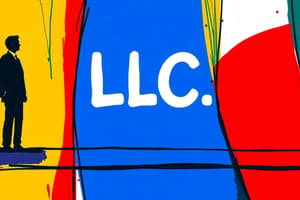Podcast
Questions and Answers
According to Weber, what is a primary characteristic of bureaucratic management?
According to Weber, what is a primary characteristic of bureaucratic management?
- A focus on rules, regulations, and clear authority lines (correct)
- A structure based on personal relationships and empathy
- Prioritizing employee feelings over organizational rules
- Flexible and adaptable decision-making processes
Which of Maslow's needs is at the highest level in his hierarchy?
Which of Maslow's needs is at the highest level in his hierarchy?
- Self-actualization (correct)
- Safety
- Belonging
- Esteem
What is the primary focus of a differentiation strategy?
What is the primary focus of a differentiation strategy?
- Minimizing costs to offer the lowest price
- Maintaining standard offerings in all markets
- Targeting a specific market segment with specialized offerings
- Developing a unique product that stands out from the competition (correct)
Which management approach suggests there is no single best way to manage and that it depends on the situation?
Which management approach suggests there is no single best way to manage and that it depends on the situation?
What is the most significant characteristic of a cost leadership strategy?
What is the most significant characteristic of a cost leadership strategy?
Which decision-making style relies most heavily on experience and 'gut feeling'?
Which decision-making style relies most heavily on experience and 'gut feeling'?
What is the core characteristic of a focus business strategy?
What is the core characteristic of a focus business strategy?
What are the fundamental concepts regarding business ethics?
What are the fundamental concepts regarding business ethics?
What is a key advantage of a sole proprietorship?
What is a key advantage of a sole proprietorship?
Which structure allows for shared decision-making and shared liabilities?
Which structure allows for shared decision-making and shared liabilities?
What is one characteristic of a Limited Liability Company (LLC)?
What is one characteristic of a Limited Liability Company (LLC)?
What is the primary focus of scientific management?
What is the primary focus of scientific management?
Which management function involves monitoring activities and ensuring alignment with plans?
Which management function involves monitoring activities and ensuring alignment with plans?
What is the primary purpose of the organizing function in management?
What is the primary purpose of the organizing function in management?
Which of the following is a characteristic of a cooperative?
Which of the following is a characteristic of a cooperative?
Administrative management emphasizes which of the following functions?
Administrative management emphasizes which of the following functions?
Flashcards
Sole Proprietorship
Sole Proprietorship
A business owned and run by one person. The owner receives all profits but is personally responsible for all debts.
Partnership
Partnership
A business owned and run by two or more people. Partners share profits and liabilities.
Limited Liability Company (LLC)
Limited Liability Company (LLC)
Combines limited liability protection with tax benefits of a sole proprietorship or partnership. Owners are not personally liable for the company's debts.
Corporation
Corporation
Signup and view all the flashcards
Planning
Planning
Signup and view all the flashcards
Organizing
Organizing
Signup and view all the flashcards
Leading
Leading
Signup and view all the flashcards
Controlling
Controlling
Signup and view all the flashcards
Bureaucratic Management
Bureaucratic Management
Signup and view all the flashcards
Behavioral Management
Behavioral Management
Signup and view all the flashcards
Contingency Management
Contingency Management
Signup and view all the flashcards
Differentiation Strategy
Differentiation Strategy
Signup and view all the flashcards
Cost Leadership Strategy
Cost Leadership Strategy
Signup and view all the flashcards
Focus Strategy
Focus Strategy
Signup and view all the flashcards
Rational Decision Making
Rational Decision Making
Signup and view all the flashcards
Intuitive Decision Making
Intuitive Decision Making
Signup and view all the flashcards
Study Notes
Business Organization Structures
- Sole Proprietorship: A business owned and run by one person. Simplicity of setup is a key advantage. Owner receives all profits but bears all liabilities.
- Partnership: A business owned and run by two or more individuals. Often involves a shared decision-making process. Partners share in profits and liabilities. Can be general (equal liability) or limited (limited liability for some partners). Needs a formal partnership agreement.
- Limited Liability Company (LLC): Combines the limited liability of a corporation with the tax benefits of a partnership or sole proprietorship. Owners (members) are not personally liable for the company's debts. Flexibility in management structure.
- Corporation: A separate legal entity from its owners (shareholders). Offers the strongest protection from liability. Complex to set up, but potentially offers greater access to capital through stock sales. Subject to corporate taxation.
- Cooperative: A business owned and operated by its members for their mutual benefit. Can be consumer or worker cooperatives. A focus on shared values and community goals.
Management Functions
- Planning: Defining objectives, establishing strategies for achieving those objectives, and developing detailed plans. This involves forecasting future conditions, identifying potential risks, and resource allocation.
- Organizing: Structuring the business, assigning tasks, and establishing reporting relationships. This includes defining roles and responsibilities, coordinating efforts, and clarifying lines of communication.
- Leading: Motivating and inspiring employees to achieve business objectives. This involves communication, coaching, and conflict resolution.
- Controlling: Monitoring activities and ensuring they are consistent with plans. This includes measuring performance against goals, identifying deviations, and taking corrective action to rectify issues.
Management Theories
- Scientific Management (Taylorism): Focuses on optimizing efficiency and productivity by applying scientific principles to work processes. Breaking down tasks, standardization, and time studies are key elements.
- Administrative Management (Fayol): Focuses on principles of effective management in all organizations. Emphasizes functions like planning, organizing, command, coordination, and control. Establishing clear roles and responsibilities is important.
- Bureaucratic Management (Weber): Focuses on creating a structured and hierarchical organization based on rules, regulations, and clear lines of authority. Imparting objectivity and efficiency. However, can also lead to rigidity and slow decision-making.
- Behavioral Management (Maslow): Emphasizes the importance of understanding human behaviour in the workplace. Motivating employees using a hierarchy of needs. Physiological, safety, belonging, esteem, and self-actualization.
- Contingency Management: Recognizes that there is no one best way to manage; the most effective management approach depends on the specific circumstances. Adjusting style based on various factors including situational context, people, and resources.
Business Strategy
- Differentiation Strategy: Focusing on creating a unique product or service that stands out from competitors. Developing unique features and characteristics that customers value.
- Cost Leadership Strategy: Focusing on producing goods and services at a lower cost than competitors, and offering competitive pricing. Reducing costs across the board to make your offering more attractive to the consumer.
- Focus Strategy: Targeting a specific niche market or segment and providing highly specialized products or services that meet the unique needs of customer groups. A highly targeted marketing and customer service approach.
Decision Making
- Rational Decision-Making: A systematic approach that involves defining the problem, identifying alternatives, evaluating alternatives, selecting the best alternative, and implementing the chosen solution. Often associated with scientific or analytical approaches.
- Intuitive Decision-Making: Making decisions based on feelings, experience, and judgment. Faster, but may lack structure or support. Often relies upon 'gut' feelings and previous encounters.
- Group Decision-Making: Making decisions through discussions and collaboration. Can lead to diverse perspectives and shared responsibility, but also slower than individual choices.
Business Ethics
- Ethical considerations are vital in all business practices. Transparency, honesty, and fairness in business dealings. Compliance with laws and regulations is fundamental.
- Social responsibility: Businesses must consider the impact of their actions on society and the environment, and prioritize sustainable practices and ethical behaviour.
Studying That Suits You
Use AI to generate personalized quizzes and flashcards to suit your learning preferences.
Description
Test your knowledge on different business organization structures, including sole proprietorships, partnerships, limited liability companies (LLCs), and corporations. This quiz explores the advantages, liabilities, and characteristics of each type of business entity. Perfect for students of business or anyone looking to understand the legal frameworks of business operations.



